
Use code BUILD for 20% off
Book here!
Use code BUILD for 20% off
Book here!Considering installing a solar PV system to generate electricity? Solar photovoltaic (PV) panels have become something of a panacea in sustainable building. Keen to generate your own power? Go solar. Want to be off grid? Go solar (and move south). Want to say your building is net energy positive? Add way more PV.
But there’s no such thing as a free lunch. There are several questions around solar panels that need addressing before reaching the conclusion, as so many have, that solar PV is simply the best way to generate energy and there are no downsides to the equation. And, thanks to a mixture of government incentives and falling technology prices, demand for solar PV has boomed over the last decade.
Here, we explain the basics of how a solar pv system works, before taking a deep dive into solar panel costs, payback periods and what can affect the amount of time it takes for your investment to pay off.
How does a solar PV system work and how does it generate useful electricity? Photovoltaic generation (PV) takes energy from light (photons) and transforms it into electricity (volts). Photovoltaic cells produce very small amounts of power, so they’re grouped into modules. A panel consists of several modules linked together. Where multiple units are grouped together this is known as a solar pv array.
The power generated by PV cells is direct current at low voltage. Unless the power is being used solely to run low-voltage, direct current (d/c) appliances, it needs to be converted to 240V alternating current (a/c) – ie normal domestic electricity – by means of an inverter. A cable connects the solar panels to the inverter and the system is then linked to the mains. Any electricity which isn’t immediately used on site can either be stored in a battery or exported to the grid.
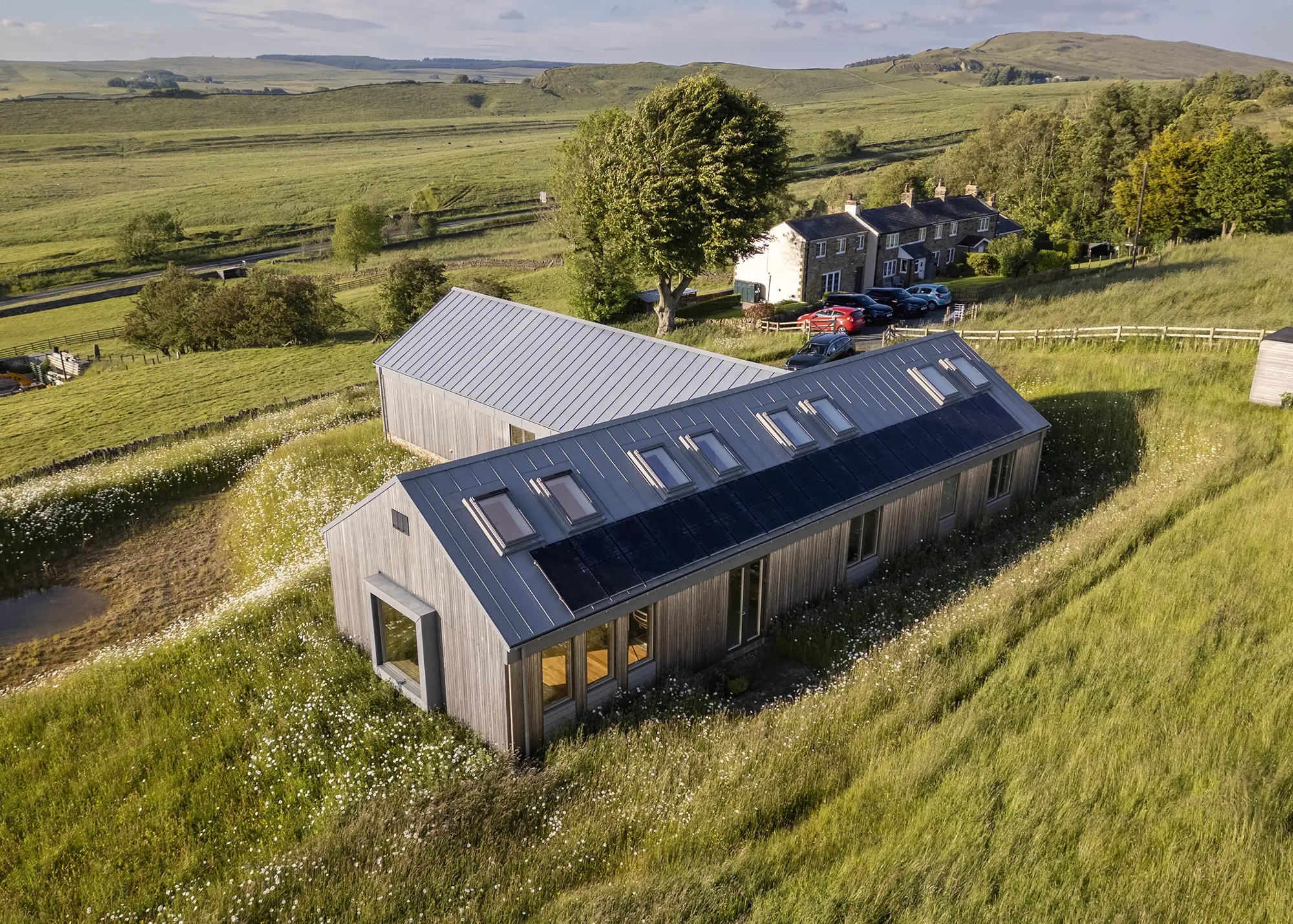
This sympathetic one-and-a-half-storey SIPs self build by SIPS@Clays features a range of renewable systems to achieve net zero carbon, including a 6.4kW solar PV array, 3kW wind turbine and an MVHR system
To maximise yield, solar panels should be orientated to face south, though a useful lower yield will still be achieved from solar panels facing southwest to southeast. At east or west orientation the yield starts to fall significantly. At our latitude in the UK, the angle for collectors to be installed to maximise yield is 35° from the horizontal. Fortunately, this is consistent with the most common roof types in this country, so if you have a south-facing pitched roof you can most likely get close to the maximum yield simply by fitting solar panels on the existing structure.
Of course, you need to avoid overshading, as trees or nearby buildings on the southern aspect of the installation will sharply reduce the output of your solar pv system. PV can also be fitted on flat roofs by using suitably angled mounting brackets. In independent installations, yield can be increased by using a solar tracker which turns the panels to follow the sun, so the array is always angled towards it.
Solar electric panels are rated according to their performance in optimum conditions (i.e. direct sunlight during summertime, or – to get technical –under full solar radiation). This is expressed as kilowatts peak (kWp).
A typical domestic setup will be rated somewhere between 3.5kWp and 4kWp – but the exact specification will depend on a variety of factors, such as the size of the house, number of occupants and current/future electricity needs.
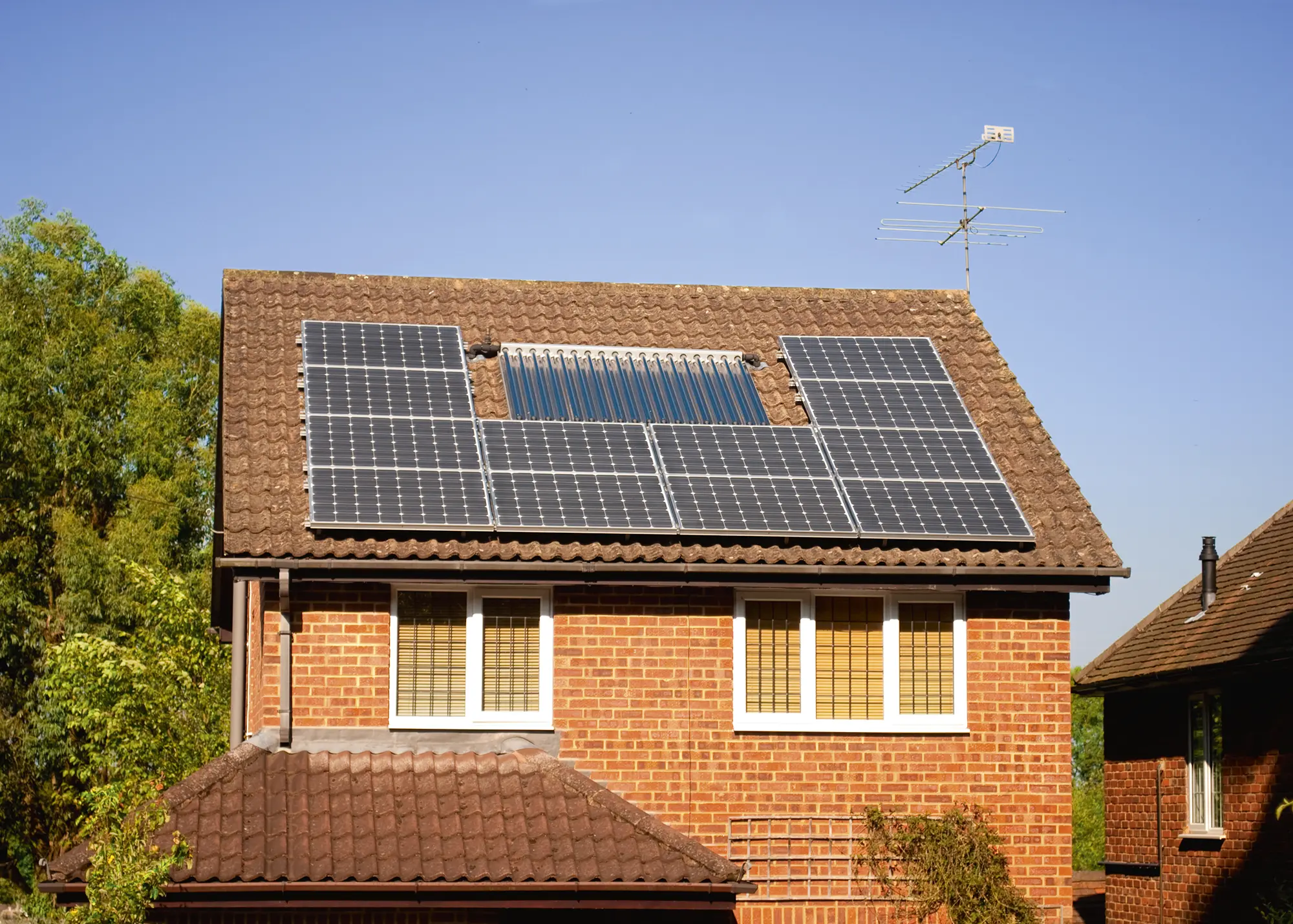
Photo: Rof f Wylam / shutterstock
Depending on the system you use, you can expect to require around 8m² of roof space per kWp. As a rule, 1kWp of solar PV panels installed on a south-facing roof at a good pitch will provide around 800-1,000kWh of electricity per year. This will vary according to your home’s location in the UK – a well-oriented roof in the Devon countryside is likely to get more sun than an inner-city equivalent in Liverpool, for example.
On average, a 3.5kWp setup might deliver 2,800 to 3,500kWh of electricity – which equates to the majority of an average household’s annual electricity requirement. But don’t expect to rely on the panels all year round.
Adding battery storage will increase the percentage of energy used at home rather than exported to the grid, but it will substantially increase your initial costs when installing a solar PV system, so won’t reduce your payback period. Instead, you can improve the equation by doing energy-intensive things, such as washing clothes, during the daytime when your solar panels are generating power.
Battery storage can, however, be used to buy and store grid electricity at night, which is cheaper. This can then be used during peak hours instead of importing electricity at full rate. This is a game-changer in terms of the economics of battery storage, but in and of itself doesn’t mean that PV is any more sustainable.
your guide to solar battery storage
Most domestic solar photovoltaic panels are fitted to the property’s roof, ideally one that’s on a south-facing elevation and offers a 30 to 40° pitch to maximise the array’s exposure to light. Fitting the PV units is a fairly painless process, and most jobs can be completed in two or three days. If you’re building a home from scratch, then you can make allowances for the above in your architectural brief.
“Considering solar when you’re in the early design phase makes a lot of sense, as you can make sure your solar electric panels are orientated and fitted as efficiently as possible,” says Steve Springett, chief product officer at Tonik Energy.
“There’s also an opportunity to save relative to retrofitting solar panels. Scaffolding and mobilisation make up the majority of the installation cost – the panels themselves are relatively affordable. So it’s a great opportunity to get value for money.”
There are two main options for installing the panels. The first is an ‘on-roof’ solar PV system, where the modules are fitted in a mount that’s anchored to the rafters. This method is particularly suited to retrofits, as it involves minimal disruption.
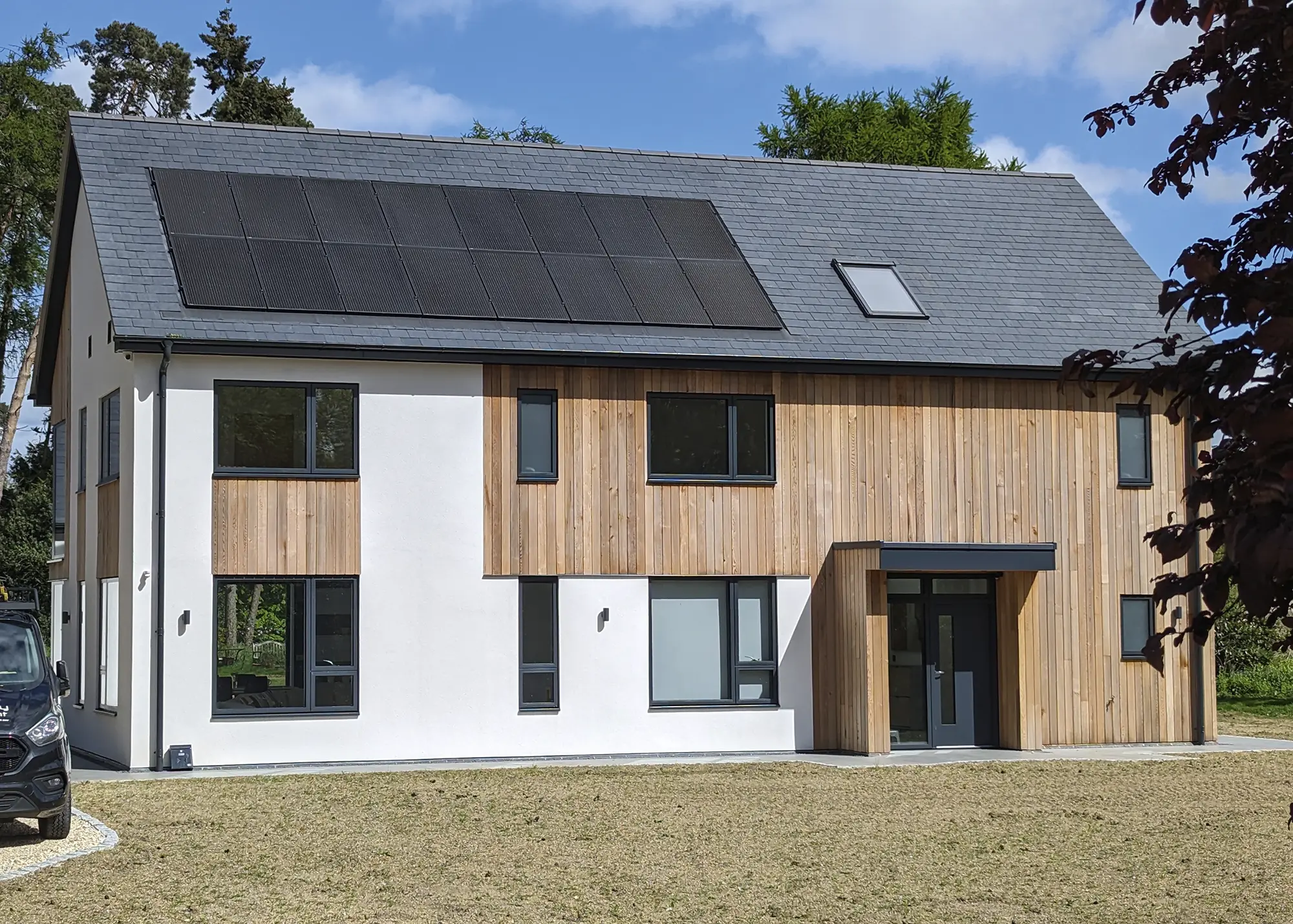
Fitted on the roof of a contemporary new home, this solar array was manufactured by Solarwatt. Eco Energy Environment both supplied and installed the setup
If your roof is already tiled, these will need to be lifted, the anchors fixed and the tiles replaced before the mount is attached. With some slate roofs, it’s preferable to leave the covering in situ and drill through to provide a fixing. In both cases, the panels sit slightly proud of the covering to provide a ventilation gap.
The second option is an ‘in-roof’ or integrated system, which is often preferred for self builds or big renovation projects where the structure is already being re-roofed. With this method, the solar panels are fitted on the same plane as the covering for a sleeker finish, with a flashing kit used to provide waterproofing.
You can even choose to install individual solar tiles or slates, available from suppliers such as Solex. As with any solar PV system, ventilation is important, so your installer may counter-batten to provide good airflow.
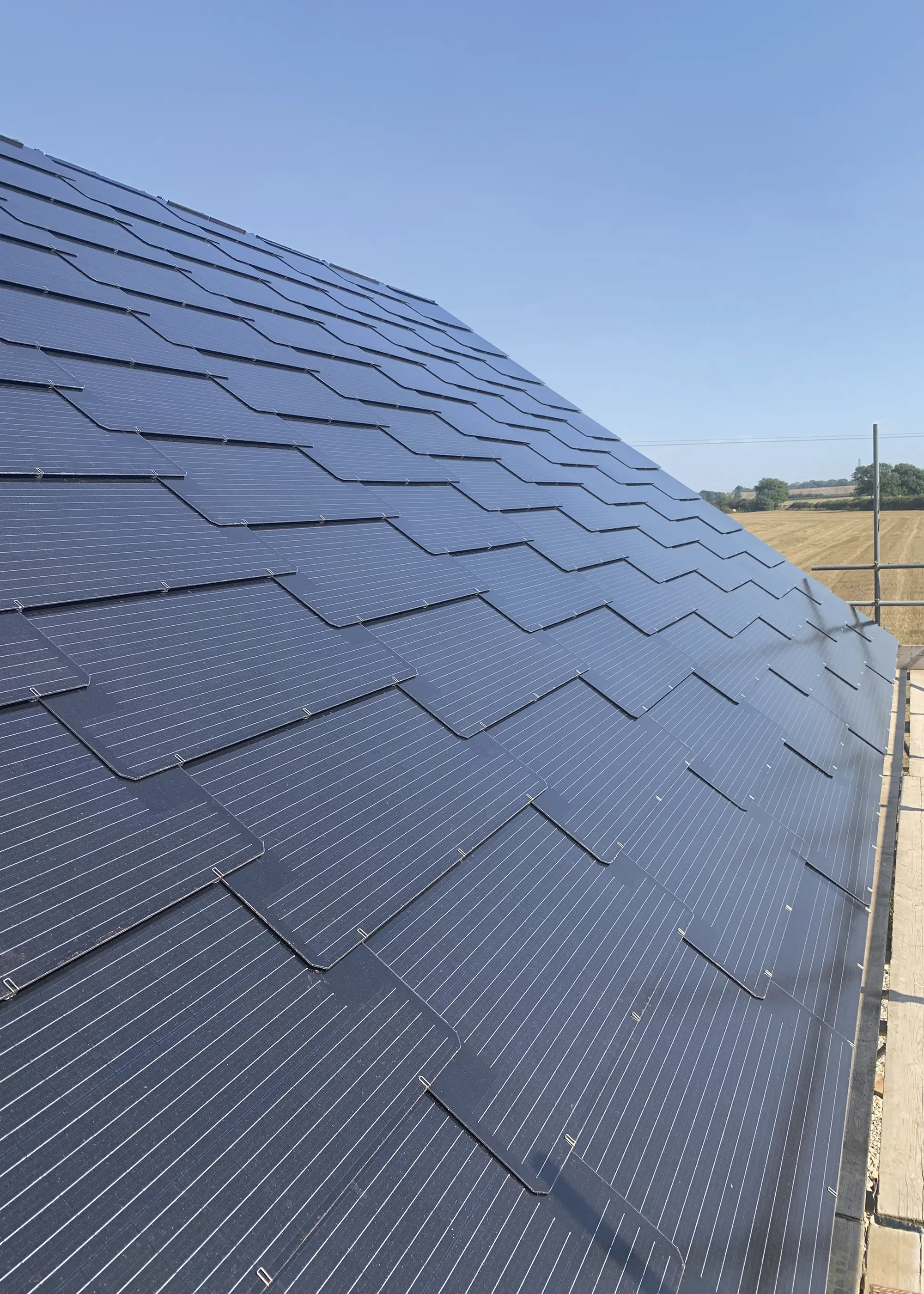
Solex’s solar roof tiles function as electricity generators, as well as providing a roof covering that blends seamlessly with the design of the house. The tiles can be fitted to cover the whole roof covering from edge to edge, all the way from the eaves to the ridge and out to the verge and hips/valleys. They also interlock seamlessly with natural slate roof tiles if you only want to install solar panels on one section of the roof
Solar tiles are an interesting alternative to panels, having the advantage that they are virtually invisible, and can even pass muster in conservation areas. This comes at a greater cost, though – perhaps 50% more than a panel system.
Alternatives include ground-mounted panels (which literally sit in a frame in your garden) or flat roof installations. In the latter case, the modules are usually fitted at a greater pitch than the roof to maximise the amount of strong daylight to which they’re exposed.
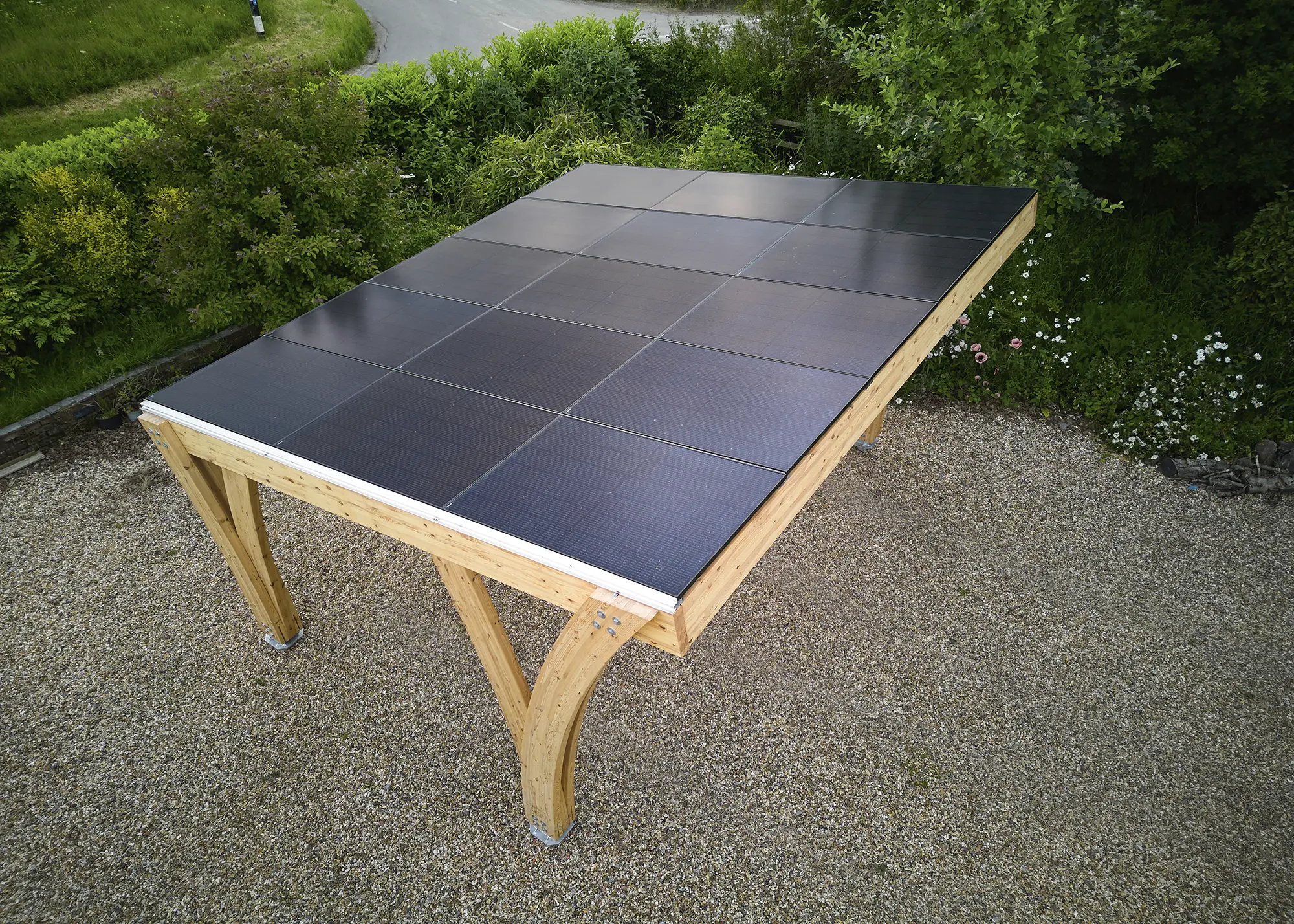
Bifacial solar PV panels form the roof of this property’s carport in Wiltshire. Pure Energy UK also installed battery storage and an EV charger as part of the setup
New ground-mounted products that move to track the sun’s path can deliver an efficiency advantage over static systems.
EXPERT VIEW Installing in-roof solar panelsYen Dai from Eco Energy Environment reveals the importance of engaging a specialist installer early in the design phase to ensure solar panel success: Time and time again a client will come to us after obtaining planning permission, very pleased that their house designer has factored in for X number of solar panels. A great deal of architects think solar design is straightforward, ie you just put them on the roof, but there are things that need to be taken into consideration. The best way to deal with these issues is by bringing a specialist solar panel installer on board at the early design stages. One common problem occurs where an in-roof system is required, which means the panels are installed flush into the roof. While an architect can reach out to a manufacturer to get dimensions, many don’t realise that there also needs to be flashing (a tray for the panels). Even if this is highlighted to them, no one then explains that there should be a buffer around the edges – one and a half tiles on the sides, and two rows on the top and bottom of the array. When we come in late and see that there physically isn’t the space to allow for the flashing or minimum row of tiles, it means the client will have to lose some panels – so people get very disappointed. We’ve even had a project where the couple decided, at a later stage, to put in a log burner with the flue coming straight through the roof. They didn’t tell us. When we climbed up to the roof to install the panels, it was impossible – the flue was right in the way. |
Solar PV systems are measured in terms of kWp – kilowatts peak. This is the amount of energy that a solar PV system can generate when operating at full power, ie in the middle of a sunny day. Costs are normally expressed in £/kWp. So, if a typical domestic solar PV system was 4kWp and cost £6,000, we’d say the cost is £1,500 per kWp. This includes not just the collectors, but the inverter, controls, wiring and installation, too.
Surprisingly, it’s quite difficult to nail down average costs of a solar PV system. They seem to have risen in recent years before falling back a little recently – but data is sparse. Plenty of websites claim that a 4kWp system costs between £5,000 and £6,000, but the database of approved installers under the Microgeneration Certification Scheme (MCS) suggests the current cost is over £2,000 per kWp.
In theory, it should cost less to install a solar pv system if you’re building a new house than if you’re retrofitting the panels on an existing one, as scaffolding is already in place and you have ready access to wiring routes etc. Built-in solar PV systems (BIPV), where the collectors form part of the roof covering, should offer a small saving in deducted roof finish materials to offset the capital cost of the system.
It’s also worth bearing in mind that the inverter is expected to need replacing at least once during the solar PV system’s lifetime. Again, data is sparse but it’s wise to factor in this additional cost from the outset.
QUICK GUIDE Smart Export Guarantee for solar PVThe government’s Feed-in Tariff, which paid out to homeowners both for the generation and for the excess electricity their solar PV systems produced, closed to new applicants on 31 March 2019. Its replacement, the Smart Export Guarantee (SEG), has since been rolled out, and is delivered via energy suppliers. Companies with more than 150,000 customers are required to offer at least one export tariff. It’s up to suppliers to decide exactly what Smart Export Guarantee payments they will customers for each kWh of electricity exported. There’s a wide range of SEG tariffs depending on who you use for your energy and whether you’re bought your solar panels independently or via the energy company. The Solar Trade Association’s website has a league table of tariffs. In order to qualify, installations must currently be certified through the Microgeneration Certification Scheme or a suitable equivalent, such as Solar Keymark. |
The amount of time it takes for an investment in a solar PV system to pay back through reductions in energy bills is known as the payback period. Of course, there’s a difference between cash spent now and money saved in the future – you’d rather have £1 now than £1 in 10 years’ time, because that money will go further today.
Future savings should therefore be discounted to arrive at the present value to compare them with capital cost. Using the Treasury’s current Green Book rate of 3.5%, £1 in a decade’s time should be treated as the equivalent of 70p now. So, the value of future payments will gradually diminish over time. After 20 years, the value is less than half. However, electricity prices are expected to rise gradually, so this might well offset the interest rate.
As such, payback times are normally expressed in terms of simple payback – cost divided by savings based on the current price of electricity. This sum is dependent on:
If you’re out most of the day and don’t have battery storage to store the electricity generated by your solar PV system, the bulk of the energy produced is exported to the grid. It’s not straightforward to say how much you’ll be paid for this, as the Smart Export Guarantee scheme only stipulates the rate should be above zero. To get the best tariffs there are many conditions attached, and rates can vary according to time of day. Generally, the export rate is much lower than what you pay to buy your electricity in.
So, in the example (below), with no allowance for the cost of inverter replacement, the payback period would be about 15 years. After that, you start to see a net return against your initial outlay. This can be compared to the average life of a PV system, commonly quoted as 25 years. Therefore, you can expect the system to pay back within its lifetime. Factor in inverter replacement and the payback would be only just within the expected lifetime.
| EXAMPLE PAYBACK PERIOD | |
|---|---|
| Size of system | 4kWp |
| Cost of system | £7,000 |
| Output per kWp | 800kWh/kWp |
| Total annual generation | 3,200kWh |
| Cost of electricity displaced | 20p/kWh |
| Percentage used on site | 50% |
| Annual saving (3,200 kWh x £0.2 x 0.5) | £320 pa |
| Percentage exported | 50% |
| Export payment | 10p/kWh |
| Annual value of exports | £160 pa |
| Total saving | £480 pa |
| Payback period (£7,000 / £480) | 15 years |
The power output generated by any solar pv system falls slightly each year, but this drop is thought to be less than 1% per annum. The rate of degradation may differ between manufacturers and solar panels, so it’s essential to check independently verified data on long term performance before deciding which solar PV solution best suits your home. At 0.8% per annum, the fall in output would only be 18% by year 25, but this still has a modest impact on the payback equation.
Solar Panels FAQs AnsweredQ) Who should design my solar panel system? It’s always best engage with a specialist solar panel company right at the very beginning of your project – whether you’re retrofitting or building a new house. If you’re self building or reconfiguring the roof, put the solar expert in contact with your house designer to collaborate. If a specialist solar installer can only suggest solutions, such as moving roof windows, once the planning design is already finalised, some architects can be reluctant because they feel it might spoil their vision for the aesthetics. Q) Do I need planning permission for solar panels? In general, solar panels fall under permitted development (PD) rights, so you don’t need planning. However, if you’re in an area of outstanding natural beauty, conservation area, are working on a listed building or installing a ground mount, you will need planning permission. Q) Can solar panels be recycled? We now have a UK recycling facility and this is set to get bigger as installs start to come to the end of their life. Components are broken down into their constituent parts and most of the material is then reused. There is a significant energy component to this process and for thin film application there are concerns about the use of cadmium, but it’s possible for polycrystalline panels (the majority of systems) to be recycled safely. |
Additional content by Build It expert, Nigel Griffiths. This article has been updated in February 2025.

Comments are closed.